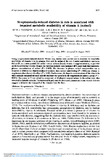| dc.contributor.author | Tuitoek, Prisca J. | |
| dc.contributor.author | Ziari, S. | |
| dc.contributor.author | Tsin, A.T. | |
| dc.contributor.author | Rajotte, R.V. | |
| dc.contributor.author | Suh, M. | |
| dc.contributor.author | Basu, T.K. | |
| dc.date.accessioned | 2017-08-31T12:19:50Z | |
| dc.date.available | 2017-08-31T12:19:50Z | |
| dc.date.issued | 1996-04 | |
| dc.identifier.citation | Br J Nutr. 1996 Apr;75(4):615-22. | en_US |
| dc.identifier.uri | https://www.ncbi.nlm.nih.gov/pubmed/8672413 | |
| dc.identifier.uri | http://hdl.handle.net/123456789/2765 | |
| dc.description.abstract | Using streptozotocin-induced diabetic Wistar rats, studies were carried out to examine the metabolic availability of vitamin A in the plasma, liver and the retina of the eye. Control and diabetic rats were fed ad lib. on a semi-purified diet either with or without (basal) vitamin A supplementation, or pair-fed on the basal diet for 4 weeks. Despite the fact that diabetic rats consumed 48% more feed, they had lower plasma concentrations of retinol (P < 0.003). The decrease in plasma retinol concentration was a response to diabetes (or diabetes-induced trauma), since neither pair-feeding (P < 0.01) nor vitamin A supplementation altered this effect (P < 0.05). Furthermore, the hepatic concentrations of the vitamin in these animals remained elevated and this increase was greater in the supplemented diabetic group (P < 0.001). Decreases in 11-cis retinal (a component of rhodopsin) concentrations in the retina were also observed in diabetic animals. The increased hepatic and the decreased plasma and retina vitamin A levels suggest a defect in the transport of the vitamin from the liver. | en_US |
| dc.language.iso | en | en_US |
| dc.publisher | The British Journal of Nutrition | en_US |
| dc.title | Streptozotocin-induced diabetes in rats is associated with impaired metabolic availability of vitamin A (retinol). | en_US |
| dc.type | Article | en_US |

